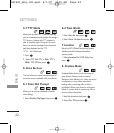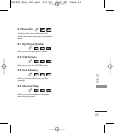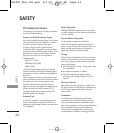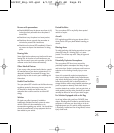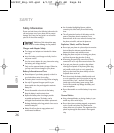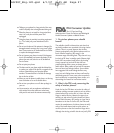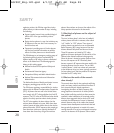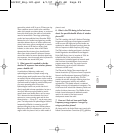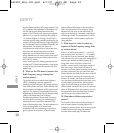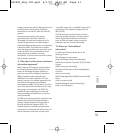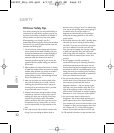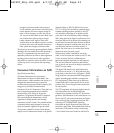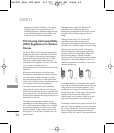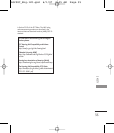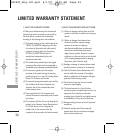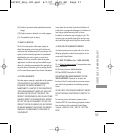
33
SAFETY
emergency assistance number when necessary.
Certain situations you encounter while driving may
require attention, but are not urgent enough to
merit a call for emergency services. But you can
still use your wireless phone to lend a hand. If you
see a broken-down vehicle posing no serious
hazard, a broken traffic signal, a minor traffic
accident where no one appears injured or a vehicle
you know to be stolen, call roadside assistance or
other special non-emergency wireless number.
The above tips are meant as general guidelines. Before
deciding to use your mobile device while operating a
vehicle, it is recommended that you consult your
applicable jurisdiction’s local laws or other regulations
regarding such use. Such laws or other regulations
may prohibit or otherwise restrict the manner in which
a driver may use his or her phone while operating a
vehicle.
Consumer Information on SAR
(Specific Absorption Rate)
This Model Phone Meets the Government’s
Requirements for Exposure to Radio Waves. Your
wireless phone is a radio transmitter and receiver. It is
designed and manufactured not to exceed the
emission limits for exposure to Radio Frequency (RF)
energy set by the Federal Communications
Commission of the U.S. Government. These limits are
part of comprehensive guidelines and establish
permitted levels of RF energy for the general
population. The guidelines are based on standards
that were developed by independent scientific
organizations through periodic and thorough
evaluation of scientific studies. The standards include
a substantial safety margin designed to assure the
safety of all persons, regardless of age and health.
The exposure standard for wireless mobile phones
employs a unit of measurement known as the Specific
Absorption Rate, or SAR. The SAR limit set by the
FCC is 1.6 W/kg. Tests for SAR are conducted using
standard operating positions specified by the FCC
with the phone transmitting at its highest certified
power level in all tested frequency bands. Although
SAR is determined at the highest certified power level,
the actual SAR level of the phone while operating can
be well below the maximum value. Because the phone
is designed to operate at multiple power levels to use
only the power required to reach the network, in
general, the closer you are to a wireless base station
antenna, the lower the power output.
Before a phone model is available for sale to the
public, it must be tested and certified to the FCC that
it does not exceed the limit established by the
government-adopted requirement for safe exposure.
The tests are performed in positions and locations
(e.g., at the ear and worn on the body) as required by
the FCC for each model.
The highest SAR value for this model phone when
tested for use at the ear is 1.3 W/kg and when worn
on the body, as described in this user guide, is 0.886
W/kg (body-worn measurements differ among phone
models, depending upon available accessories and
FCC requirements). While there may be differences
between SAR levels of various phones and at various
positions, they all meet the government requirement
for safe exposure.
The FCC has granted an Equipment Authorization for
this model phone with all reported SAR levels
evaluated as in compliance with the FCC RF emission
guidelines. SAR information on this model phone is on
file with the FCC and can be found under the Display
Grant section of http://www.fcc.gov/oet/fccid after
searching on FCC ID BEJLG200C. Additional
information on Specific Absorption Rates (SAR) can
be found on the Cellular Telecommunications Industry
Association (CTIA) website at http://www.ctia.org.
* In the United States and Canada, the SAR limit for
LG200C_Eng.120.qxd 6/1/07 8:35 AM Page 33



